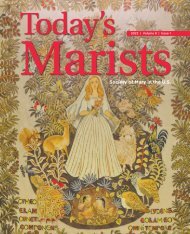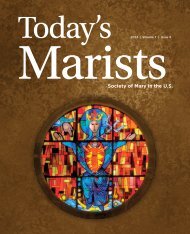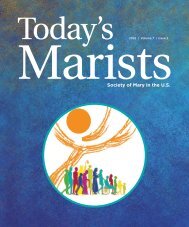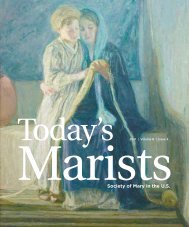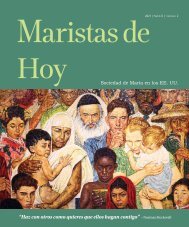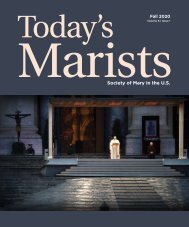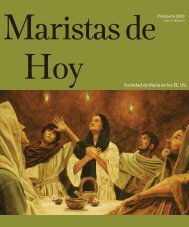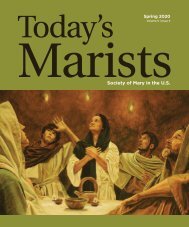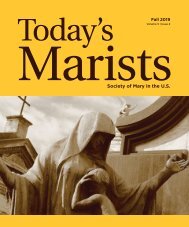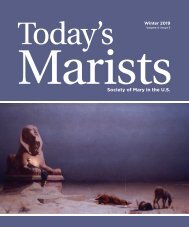Today's Marists Volume 5, Issue 1 Spring 2019
Create successful ePaper yourself
Turn your PDF publications into a flip-book with our unique Google optimized e-Paper software.
Servant Leadership and Marist Values<br />
by Mary Ghisolfo, Former President of Marist Laity<br />
“Have one ambition. While doing great things for the Lord, be unknown and even hidden<br />
in the world. The aim is to make the school a family.” (Jean-Claude Colin)<br />
I served at École Notre Dame des Victoires<br />
(NDV), a Marist K-8 elementary school<br />
in downtown San Francisco, California<br />
for 37 years beginning as the sixthgrade<br />
teacher followed by 31 years as<br />
principal. For me, the concept of “servant<br />
leader” was always a way of being in the<br />
classroom or as principal. Responding<br />
to the needs of others was my focus,<br />
especially to those who struggled with<br />
life’s challenges whether they came from<br />
students, parents, or faculty and staff.<br />
Creating a sense of community was<br />
also a major goal for me in both of my<br />
roles. Listening to the needs of students,<br />
academic and social, or being present to<br />
the needs of the faculty, staff, and parent<br />
community, I considered of paramount<br />
importance. We are all in this together, I<br />
thought.<br />
Being Present<br />
“Let us show one another not only<br />
charity, but also respect and honor.”<br />
(Jean-Claude Colin)<br />
I have always considered presence to be<br />
significant. As a teacher, I was compelled<br />
to move around the classroom observing<br />
students as they worked, encouraging and<br />
praising them for thoughtful choices, or<br />
alerting them to an aspect of their work<br />
that may need to be reworked, all of this<br />
in an effort to help them succeed. Giving<br />
positive feedback, along with caring and<br />
constructive criticism was vital. With<br />
the staff, I made it a priority to be where<br />
the action was, which could range from<br />
informal classroom walkthroughs to<br />
being present in the hallways, on the<br />
playground, gym, or cafeteria. I wanted<br />
them to know that I was there with them<br />
to ensure that “all was well.” Formal<br />
teacher meetings were scheduled once<br />
a month to discuss curriculum, student<br />
needs, or other issues. It was a good<br />
opportunity for teachers to share with<br />
me what they were excited about that was<br />
working in the classroom, and what posed<br />
challenges to them. They also created a<br />
list of questions, concerns, and comments<br />
to share with me during these meetings.<br />
Service<br />
Embracing the spirit of service was<br />
not only reflected in working with the<br />
teachers in planning student service<br />
projects, but also working alongside them.<br />
One example of this was when the art<br />
department sponsored an “Empty Bowls<br />
Dinner” during the Lenten season. To<br />
prepare for this special dinner, the faculty<br />
painted bisque ware bowls which were<br />
later used for the simple soup-and-salad<br />
meal that the school and parish families<br />
attended. Local eateries donated the food<br />
and funds raised helped to support the<br />
Gubbio Project, a ministry at a nearby<br />
Franciscan church where the homeless<br />
slept in the pews during the day and then<br />
offered a meal as well as various support<br />
services. (www.thegubbioproject.org)<br />
Faith and Prayer<br />
Creating opportunities for teachers’<br />
personal growth in faith and prayer was<br />
continuous. All faculty meetings opened<br />
with a prayer, and during Advent and<br />
Lent teachers were called to pray together<br />
in the St. Peter Chanel Chapel on the<br />
first floor of the school before faculty<br />
meetings. These opportunities for prayer<br />
provided them time to reflect upon and<br />
hear more clearly the Good News of<br />
Jesus. Faculty and staff also participated<br />
in retreats each January prior to the<br />
start of school. This gave everyone an<br />
opportunity to learn more about Marist<br />
spirituality and to reflect on ways to<br />
implement it both within and outside<br />
of school. For parents, “Coffee with the<br />
Principal,” informal meetings, were held<br />
twice a year to enhance home & school<br />
communication. Each gathering opened<br />
with a prayer that focused on a theme<br />
(e.g., Peace, The Work of Mary, Patience<br />
and Parenting).<br />
Hospitality<br />
Hospitality is the welcoming spirit that<br />
makes people feel appreciated and<br />
included, indeed a part of a community.<br />
This spirit was extended to new students<br />
through the “buddy” program. New<br />
students were paired with a classmate<br />
who helped answer questions and<br />
who showed them around. A similar<br />
arrangement was made for the new<br />
parents whereby a “buddy family” was<br />
assigned to help them navigate school<br />
life and to provide guidance and support.<br />
Hospitality was also extended to staff<br />
members. Knowing that many mornings<br />
teachers arrived without eating breakfast,<br />
I would bring in bagels, cookies, fruit,<br />
8 Today’s <strong>Marists</strong> Magazine



